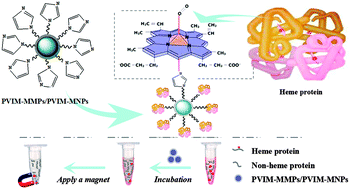Polymer decorated magnetite materials as smart protein separators to manipulate the high loading of heme proteins†
Abstract
The selective isolation and detection of protein targets from complex samples is of great significance in key life science disciplines. In this study, we integrated the advantages of magnetic materials and polymer materials to build a powerful and convenient material for the separation of heme proteins. Using free radical polymerization, the polymer coating possessing the imidazole ring was grafted onto the surface of magnetic particles. The morphology, structure and composition of the materials were characterized by transmission electron microscopy, Fourier transform infrared spectroscopy and thermogravimetric analysis. The resulting polyvinyl imidazole modified magnetic micrometer-sized particles (PVIM-MMPs) showed a strong magnetic response to an externally applied magnetic field, a remarkable adsorption capacity (6.96 g g−1) and excellent specificity (compared with non heme protein–lysozyme) and good recyclability toward the model heme protein—hemoglobin. Also a series of separating behaviours of PVIM modified magnetic nanoparticles (PVIM-MNPs) with a size of 70 nm were investigated. This research provided a guideline for selection of magnetic biomacromolecular separators in future studies.


 Please wait while we load your content...
Please wait while we load your content...